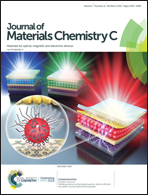A TADF compound with high-contrast mechano-responsive fluorescence on/off switching for both sequential and combinational logic gates†
Abstract
Organic luminescent materials that can be utilized for solid-state logic gate systems are in high demand, as most reported organic molecular logic gates can only work in solution. Organic materials with reversible mechano-responsive luminescence (MRL) are attractive. However, most of the logic gates based on organic MRL materials are only of the sequential type. To address this issue, the integration of high-contrast MRL and sensitive oxygen-responsive luminescence (ORL) in a rationally designed donor–acceptor type thermally activated delayed emission (TADF) luminogen (TXDM) can offer both sequential and combinational single-component logic gate systems with high-efficiency outputs, without the occurrence of chemical destruction. Based on a systematic study of this compound with only one planar acceptor and a small twist donor, two reasons at the molecular level were revealed for such a big luminescence difference between the crystalline and amorphous states of TXDM, which resulted in high-contrast MRL on/off switching. One was the destruction of anti-parallel edge-to-edge π–π stacking of its exposed planar acceptor units in the crystal, which quenched its emission. The other was excellent TADF emission induced by the production of a small singlet–triplet energy gap (ΔEST) caused by less overlap between the highest occupied molecular orbital (HOMO) and the lowest unoccupied molecular orbital (LUMO), which originated from the more twisted conformation of TXDM molecules in the amorphous state. The rational molecular design strategy toward TADF materials with high-contrast MRL switching might provide valuable insight into the development of luminescent materials with exact control of their optical properties as well.



 Please wait while we load your content...
Please wait while we load your content...